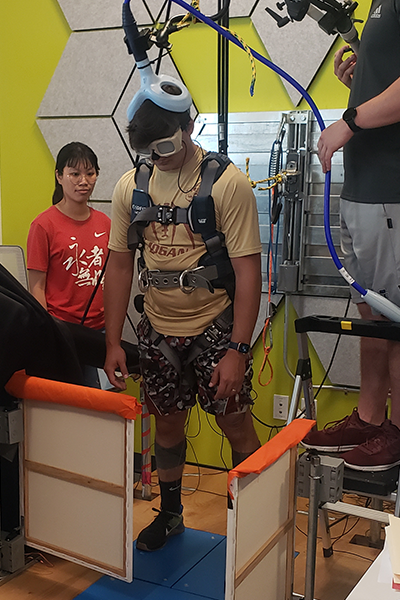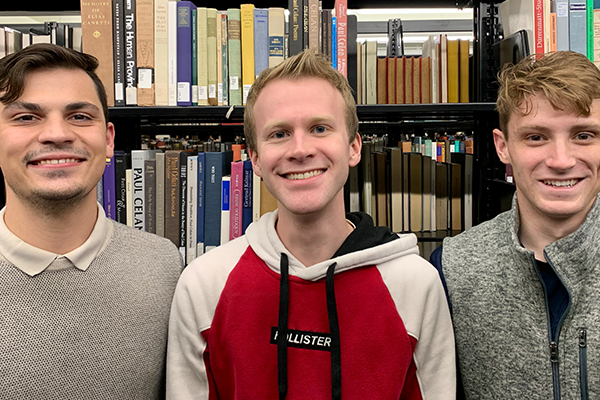Four CEHS Undergrads to Present at Research on Capitol Hill

Four undergraduate students from the Emma Eccles Jones College of Education and Human Services at Utah State University will have the opportunity to present at Research on Capitol Hill (ROCH) on February 8.
Organized by USU, ROCH is an annual celebration of undergraduate research that features students from Utah State University and the University of Utah, the top two research universities in the state. Though event organizers are planning to host the event at its traditional location in the rotunda of the State Capitol building, they are prepared to move to a virtual event if necessary (as was the case for ROCH 2021.)
This year, four students from Psychology and Kinesiology & Health Science have been accepted to present their research to Utah legislators along with top student researchers from around the state.
Each of these projects contributes to the College’s mission to enrich lives in tangible ways. Learn more about their research projects below, or view their presentations after the event.

Emma Greenwood and Marisa Davis
Marisa Davis and Emma Greenwood: Perceiving Accurate Emotions from Facial Expressions
This project studies anger race bias, which is a tendency to misinterpret an individual’s facial expressions due to their race. Davis and Greenwood are studying anger race bias as it relates to police brutality toward Black individuals, who are shot and killed by police more often than other demographics. A Black person who is displaying an expression of fear or neutrality is more likely to be perceived as displaying anger, creating hostility and increasing the likelihood than an officer will use force.
Davis and Greenwood have developed a brief training on interpreting facial expressions and are currently testing its effectiveness with undergraduate students at USU. They hope that this research can eventually be used as training for police departments, potentially decreasing police shootings of unarmed Black civilians.
Marisa Davis is a junior in Psychology. She chose to work on this project because she wants to use her education and research skills to improve others’ quality of life, and she is appreciative of the growth and perspective she has gained through her work. Emma Greenwood, a senior in Psychology, chose to participate in the project as a way to personally make a difference in the issue of police brutality, contributing to a more safe and just community. Davis and Greenwood’s research team is mentored by psychology professor Dr. Crissa Levin.

Hunter Horsley (center) tests research equipment.
Hunter Horsley: How Musculoskeletal Injury Affects Neuroplasticity
An ACL (anterior cruciate ligament) tear is one of the most common injuries for both sports athletes and tactical athletes like first responders. ACL tears are deafferentation injuries, meaning that they interrupt neurons from delivering sensory information to the brain. This project aims to study how ACL injuries affect motor control and neuroplasticity. Horsley’s team is specifically studying the ability to inhibit action (e.g., stop while running or recover from being unbalanced) in individuals who have previously torn their ACL.
Though it is common in athletics, inhibition of action is a very complex motor task. Using a controlled task that mimics a sudden switch in action, the team measures an individual’s neural activity to evaluate movement strategies and reaction times on a neural level. This data will help determine to what degree an ACL injury impacts movement inhibition. New standards for rehabilitation of ACL injuries may be needed to decrease risk of reinjury and improve the rehabilitation process overall.
Horsley is a senior in Kinesiology and Health Science with an emphasis in exercise science. Horsley is interested in orthopedics and sports medicine, and he feels that this research has helped him gain insight on the treatment of musculoskeletal injury. Horsley’s team is mentored by Kinesiology and Health Science professor Dr. Anne Beethe.

Bridger Jorgensen (left), Casey Olson, and Connor Snow
Connor Snow: Atmospheric Ammonia and its Implications for Human Health
According to national data, Cache Valley has the highest concentrations of atmospheric ammonia in the nation. This study aims to explore whether climate variables such as weather, wind, and atmospheric anomalies can be used to predict the behavior of pollutants and how human biology can be affected. An interdisciplinary collaboration, this project combines both climate science and medical data to show the human impact of a changing climate.
The research team collects samples of atmospheric ammonia to identify patterns in the level of pollutants in Cache Valley. This data is then cross-referenced to climate variables. Early investigation suggests that precipitation has the strongest ties to pollution levels, as precipitation tends to scatter ammonia particles. The team is also working to identify patterns and correlations between their climate data and hospital data related to asthma and other respiratory disease.
Snow is a senior in Kinesiology and is currently applying to medical school. He is joined in this project by fellow researchers Casey Olson, who studies climate change, and Bridger Jorgensen, who is also pursuing the medical field. The team, who began pursuing this research through their mutual friendship, hopes that learning how climate change affects human health will help them improve lives and create a more sustainable future. They are mentored by Plants, Soils, and Climate professor Dr. Simon Wang.

